Joseph B. Choi
Reduced Order Modeling of Energetic Materials Using Physics-Aware Recurrent Convolutional Neural Networks in a Latent Space (LatentPARC)
Sep 15, 2025Abstract:Physics-aware deep learning (PADL) has gained popularity for use in complex spatiotemporal dynamics (field evolution) simulations, such as those that arise frequently in computational modeling of energetic materials (EM). Here, we show that the challenge PADL methods face while learning complex field evolution problems can be simplified and accelerated by decoupling it into two tasks: learning complex geometric features in evolving fields and modeling dynamics over these features in a lower dimensional feature space. To accomplish this, we build upon our previous work on physics-aware recurrent convolutions (PARC). PARC embeds knowledge of underlying physics into its neural network architecture for more robust and accurate prediction of evolving physical fields. PARC was shown to effectively learn complex nonlinear features such as the formation of hotspots and coupled shock fronts in various initiation scenarios of EMs, as a function of microstructures, serving effectively as a microstructure-aware burn model. In this work, we further accelerate PARC and reduce its computational cost by projecting the original dynamics onto a lower-dimensional invariant manifold, or 'latent space.' The projected latent representation encodes the complex geometry of evolving fields (e.g. temperature and pressure) in a set of data-driven features. The reduced dimension of this latent space allows us to learn the dynamics during the initiation of EM with a lighter and more efficient model. We observe a significant decrease in training and inference time while maintaining results comparable to PARC at inference. This work takes steps towards enabling rapid prediction of EM thermomechanics at larger scales and characterization of EM structure-property-performance linkages at a full application scale.
Latent Representation Learning of Multi-scale Thermophysics: Application to Dynamics in Shocked Porous Energetic Material
Jun 15, 2025Abstract:Coupling of physics across length and time scales plays an important role in the response of microstructured materials to external loads. In a multi-scale framework, unresolved (subgrid) meso-scale dynamics is upscaled to the homogenized (macro-scale) representation of the heterogeneous material through closure models. Deep learning models trained using meso-scale simulation data are now a popular route to assimilate such closure laws. However, meso-scale simulations are computationally taxing, posing practical challenges in training deep learning-based surrogate models from scratch. In this work, we investigate an alternative meta-learning approach motivated by the idea of tokenization in natural language processing. We show that one can learn a reduced representation of the micro-scale physics to accelerate the meso-scale learning process by tokenizing the meso-scale evolution of the physical fields involved in an archetypal, albeit complex, reactive dynamics problem, \textit{viz.}, shock-induced energy localization in a porous energetic material. A probabilistic latent representation of \textit{micro}-scale dynamics is learned as building blocks for \textit{meso}-scale dynamics. The \textit{meso-}scale latent dynamics model learns the correlation between neighboring building blocks by training over a small dataset of meso-scale simulations. We compare the performance of our model with a physics-aware recurrent convolutional neural network (PARC) trained only on the full meso-scale dataset. We demonstrate that our model can outperform PARC with scarce meso-scale data. The proposed approach accelerates the development of closure models by leveraging inexpensive micro-scale simulations and fast training over a small meso-scale dataset, and can be applied to a range of multi-scale modeling problems.
FLRONet: Deep Operator Learning for High-Fidelity Fluid Flow Field Reconstruction from Sparse Sensor Measurements
Dec 12, 2024Abstract:The ability to reconstruct high-fidelity fluid flow fields from sparse sensor measurement is critical for many science and engineering applications, but remains a huge challenge. This challenge is caused by the large difference between the dimensions of the state space and the observational space, making the operator that provides the mapping from the state space to the observational space ill-conditioned and non-invertible. As a result, deriving the forward map from the observational space to the state space as the inverse of the measurement operator is nearly impossible. While traditional methods, including sparse optimization, data assimilation, or machine learning based regressive reconstruction, are available, they often struggle with generalization and computational efficiency, particularly when non-uniform or varying discretization of the domain are considered. In this work, we propose FLRONet, a novel operator learning framework designed to reconstruct full-state flow fields from sparse sensor measurements in space and time. FLRONet utilizes a branch-trunk architecture, where the branch network integrates sensor observations from multiple time instances, and the trunk network encodes the entire temporal domain. This design allows FLRONet to achieve highly accurate, discretization-independent reconstructions at any time within the observation window. Although the popular three-dimensional Fourier Neural Operator offers similar functionalities, our results show that FLRONet surpasses it in both accuracy and efficiency. FLRONet not only achieves superior performance in approximating the true operator but also exhibits significantly faster inference at high-fidelity discretizations.
FLRNet: A Deep Learning Method for Regressive Reconstruction of Flow Field From Limited Sensor Measurements
Nov 21, 2024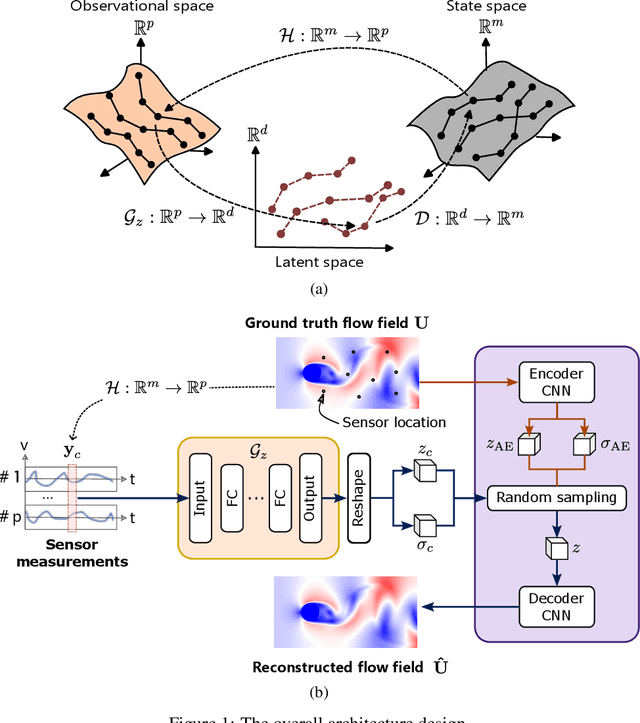


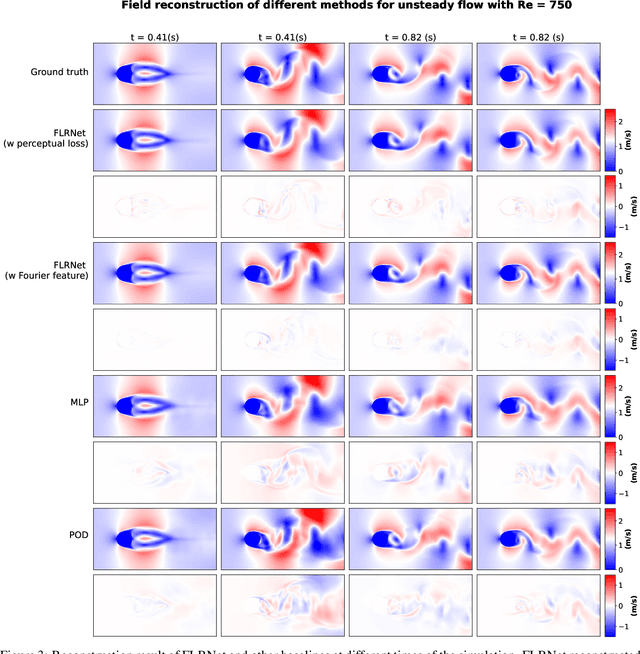
Abstract:Many applications in computational and experimental fluid mechanics require effective methods for reconstructing the flow fields from limited sensor data. However, this task remains a significant challenge because the measurement operator, which provides the punctual sensor measurement for a given state of the flow field, is often ill-conditioned and non-invertible. This issue impedes the feasibility of identifying the forward map, theoretically the inverse of the measurement operator, for field reconstruction purposes. While data-driven methods are available, their generalizability across different flow conditions (\textit{e.g.,} different Reynold numbers) remains questioned. Moreover, they frequently face the problem of spectral bias, which leads to smooth and blurry reconstructed fields, thereby decreasing the accuracy of reconstruction. We introduce FLRNet, a deep learning method for flow field reconstruction from sparse sensor measurements. FLRNet employs an variational autoencoder with Fourier feature layers and incorporates an extra perceptual loss term during training to learn a rich, low-dimensional latent representation of the flow field. The learned latent representation is then correlated to the sensor measurement using a fully connected (dense) network. We validated the reconstruction capability and the generalizability of FLRNet under various fluid flow conditions and sensor configurations, including different sensor counts and sensor layouts. Numerical experiments show that in all tested scenarios, FLRNet consistently outperformed other baselines, delivering the most accurate reconstructed flow field and being the most robust to noise.
Challenges and opportunities for machine learning in multiscale computational modeling
Mar 22, 2023



Abstract:Many mechanical engineering applications call for multiscale computational modeling and simulation. However, solving for complex multiscale systems remains computationally onerous due to the high dimensionality of the solution space. Recently, machine learning (ML) has emerged as a promising solution that can either serve as a surrogate for, accelerate or augment traditional numerical methods. Pioneering work has demonstrated that ML provides solutions to governing systems of equations with comparable accuracy to those obtained using direct numerical methods, but with significantly faster computational speed. These high-speed, high-fidelity estimations can facilitate the solving of complex multiscale systems by providing a better initial solution to traditional solvers. This paper provides a perspective on the opportunities and challenges of using ML for complex multiscale modeling and simulation. We first outline the current state-of-the-art ML approaches for simulating multiscale systems and highlight some of the landmark developments. Next, we discuss current challenges for ML in multiscale computational modeling, such as the data and discretization dependence, interpretability, and data sharing and collaborative platform development. Finally, we suggest several potential research directions for the future.
Artificial intelligence approaches for materials-by-design of energetic materials: state-of-the-art, challenges, and future directions
Nov 15, 2022Abstract:Artificial intelligence (AI) is rapidly emerging as an enabling tool for solving various complex materials design problems. This paper aims to review recent advances in AI-driven materials-by-design and their applications to energetic materials (EM). Trained with data from numerical simulations and/or physical experiments, AI models can assimilate trends and patterns within the design parameter space, identify optimal material designs (micro-morphologies, combinations of materials in composites, etc.), and point to designs with superior/targeted property and performance metrics. We review approaches focusing on such capabilities with respect to the three main stages of materials-by-design, namely representation learning of microstructure morphology (i.e., shape descriptors), structure-property-performance (S-P-P) linkage estimation, and optimization/design exploration. We provide a perspective view of these methods in terms of their potential, practicality, and efficacy towards the realization of materials-by-design. Specifically, methods in the literature are evaluated in terms of their capacity to learn from a small/limited number of data, computational complexity, generalizability/scalability to other material species and operating conditions, interpretability of the model predictions, and the burden of supervision/data annotation. Finally, we suggest a few promising future research directions for EM materials-by-design, such as meta-learning, active learning, Bayesian learning, and semi-/weakly-supervised learning, to bridge the gap between machine learning research and EM research.
A physics-aware deep learning model for energy localization in multiscale shock-to-detonation simulations of heterogeneous energetic materials
Nov 08, 2022



Abstract:Predictive simulations of the shock-to-detonation transition (SDT) in heterogeneous energetic materials (EM) are vital to the design and control of their energy release and sensitivity. Due to the complexity of the thermo-mechanics of EM during the SDT, both macro-scale response and sub-grid mesoscale energy localization must be captured accurately. This work proposes an efficient and accurate multiscale framework for SDT simulations of EM. We employ deep learning to model the mesoscale energy localization of shock-initiated EM microstructures upon which prediction results are used to supply reaction progress rate information to the macroscale SDT simulation. The proposed multiscale modeling framework is divided into two stages. First, a physics-aware recurrent convolutional neural network (PARC) is used to model the mesoscale energy localization of shock-initiated heterogeneous EM microstructures. PARC is trained using direct numerical simulations (DNS) of hotspot ignition and growth within microstructures of pressed HMX material subjected to different input shock strengths. After training, PARC is employed to supply hotspot ignition and growth rates for macroscale SDT simulations. We show that PARC can play the role of a surrogate model in a multiscale simulation framework, while drastically reducing the computation cost and providing improved representations of the sub-grid physics. The proposed multiscale modeling approach will provide a new tool for material scientists in designing high-performance and safer energetic materials.
Physics-Aware Recurrent Convolutional (PARC) Neural Networks to Assimilate Meso-scale Reactive Mechanics of Energetic Materials
Apr 04, 2022
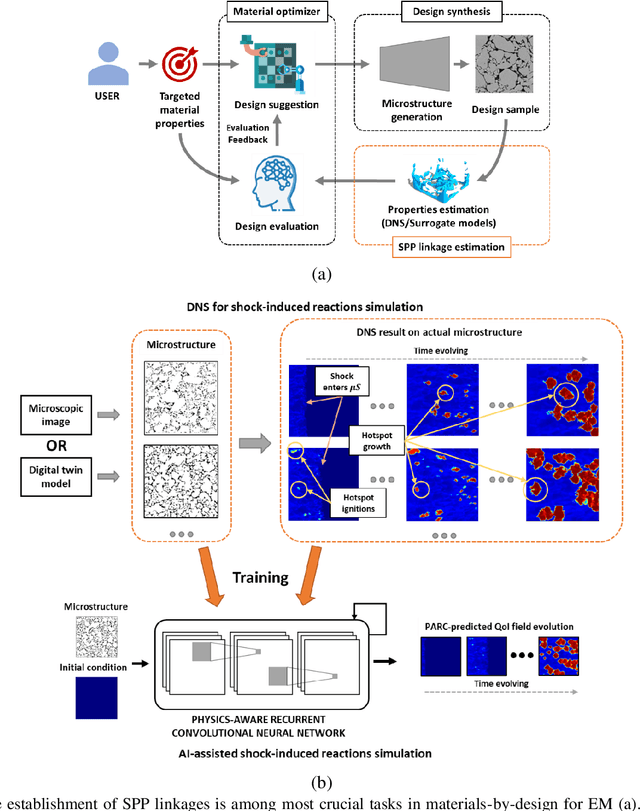

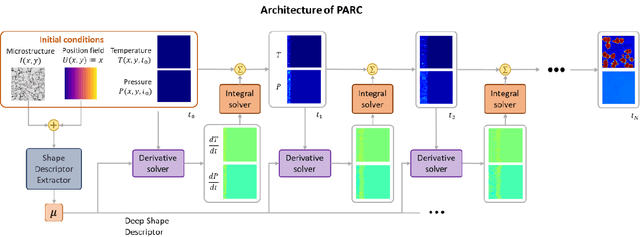
Abstract:The thermomechanical properties of energetic materials (EM) are known to be a function of their microscopic structures, i.e., morphological configurations of crystals and pores. This microstructural dependency has motivated vigorous research in the EM community, seeking to engineer material microstructures with targeted properties and performance under the materials-by-design paradigm. However, establishing the complex structure-property-performance (SPP) relationships of EMs demands extensive experimental and simulation efforts, and assimilating and encapsulating these relationships in usable models is a challenge. Here, we present a novel deep learning method, Physics-Aware Recurrent Convolutional (PARC) Neural Network, that can "learn" the mesoscale thermo-mechanics of EM microstructures during the shock-to-detonation transition (SDT). We show that this new approach can produce accurate high-fidelity predictions of time-evolving temperature and pressure fields of the same quality as the state-of-the-art direct numerical simulations (DNS), despite the dramatic reduction of computing time, from hours and days on a high-performance computing cluster (HPC) to a little more than a second on a commodity laptop. We also demonstrate that PARC can provide physical insights, i.e., the artificial neurons can illuminate the underlying physics by identifying which microstructural features led to critical hotspots and what are the characteristics of "critical" versus "non-critical" microstructures. This new knowledge generated alongside the capacity to conduct high-throughput experiments will broaden our theoretical understanding of the initiation mechanisms of EM detonation, as a step towards engineering EMs with specific properties.
Deep learning for synthetic microstructure generation in a materials-by-design framework for heterogeneous energetic materials
Apr 05, 2020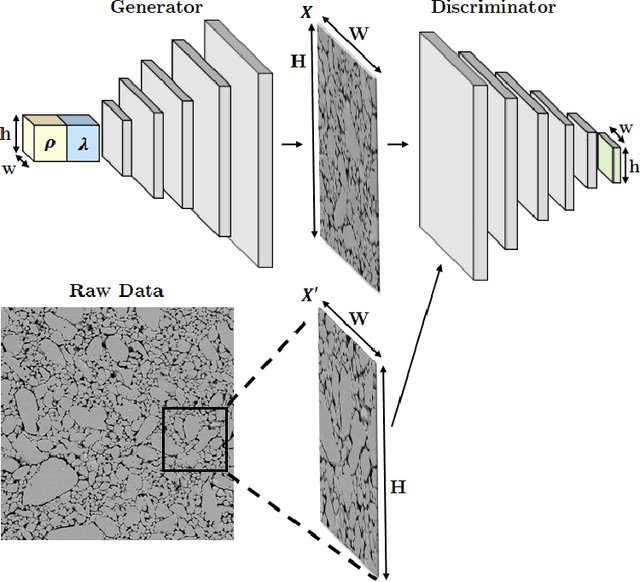
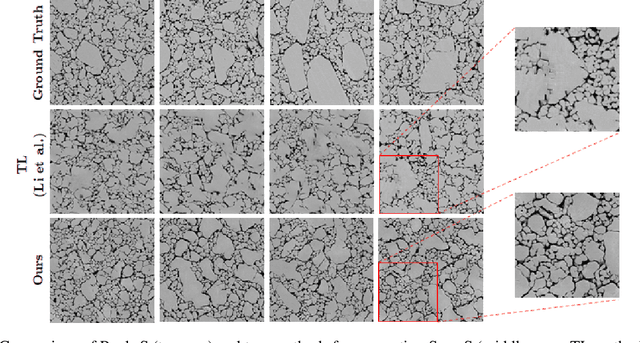


Abstract:The sensitivity of heterogeneous energetic (HE) materials (propellants, explosives, and pyrotechnics) is critically dependent on their microstructure. Initiation of chemical reactions occurs at hot spots due to energy localization at sites of porosities and other defects. Emerging multi-scale predictive models of HE response to loads account for the physics at the meso-scale, i.e. at the scale of statistically representative clusters of particles and other features in the microstructure. Meso-scale physics is infused in machine-learned closure models informed by resolved meso-scale simulations. Since microstructures are stochastic, ensembles of meso-scale simulations are required to quantify hot spot ignition and growth and to develop models for microstructure-dependent energy deposition rates. We propose utilizing generative adversarial networks (GAN) to spawn ensembles of synthetic heterogeneous energetic material microstructures. The method generates qualitatively and quantitatively realistic microstructures by learning from images of HE microstructures. We show that the proposed GAN method also permits the generation of new morphologies, where the porosity distribution can be controlled and spatially manipulated. Such control paves the way for the design of novel microstructures to engineer HE materials for targeted performance in a materials-by-design framework.
NADS-Net: A Nimble Architecture for Driver and Seat Belt Detection via Convolutional Neural Networks
Oct 08, 2019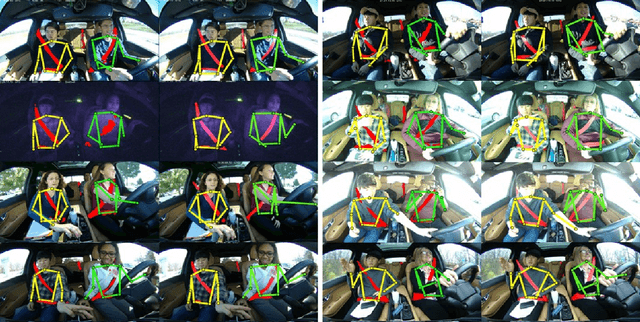
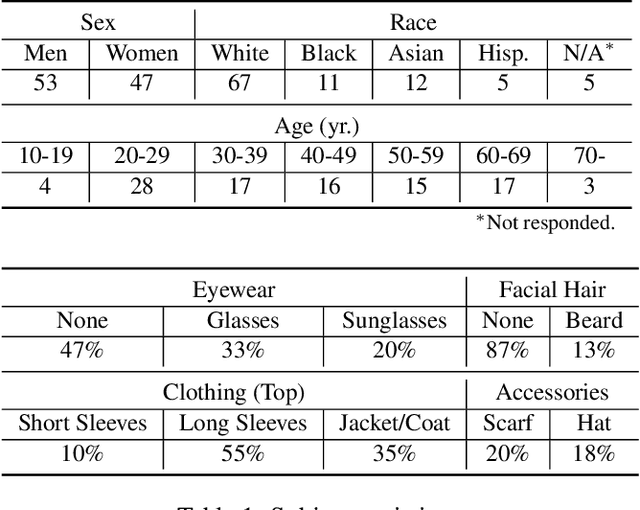
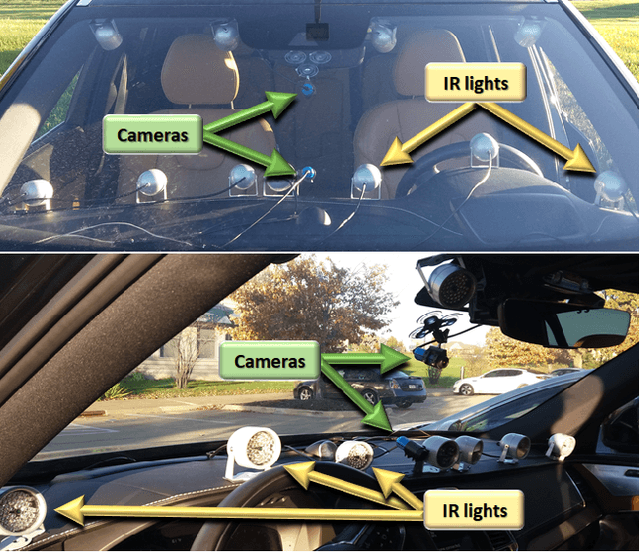
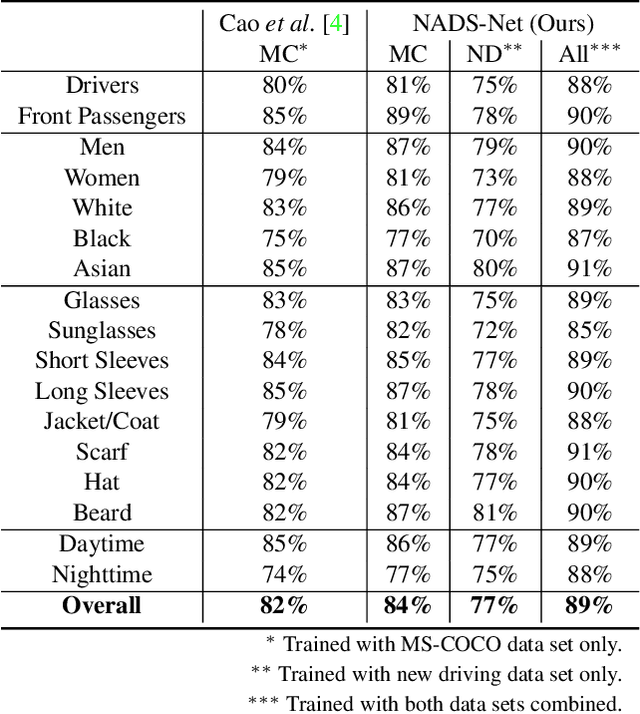
Abstract:A new convolutional neural network (CNN) architecture for 2D driver/passenger pose estimation and seat belt detection is proposed in this paper. The new architecture is more nimble and thus more suitable for in-vehicle monitoring tasks compared to other generic pose estimation algorithms. The new architecture, named NADS-Net, utilizes the feature pyramid network (FPN) backbone with multiple detection heads to achieve the optimal performance for driver/passenger state detection tasks. The new architecture is validated on a new data set containing video clips of 100 drivers in 50 driving sessions that are collected for this study. The detection performance is analyzed under different demographic, appearance, and illumination conditions. The results presented in this paper may provide meaningful insights for the autonomous driving research community and automotive industry for future algorithm development and data collection.
 Add to Chrome
Add to Chrome Add to Firefox
Add to Firefox Add to Edge
Add to Edge